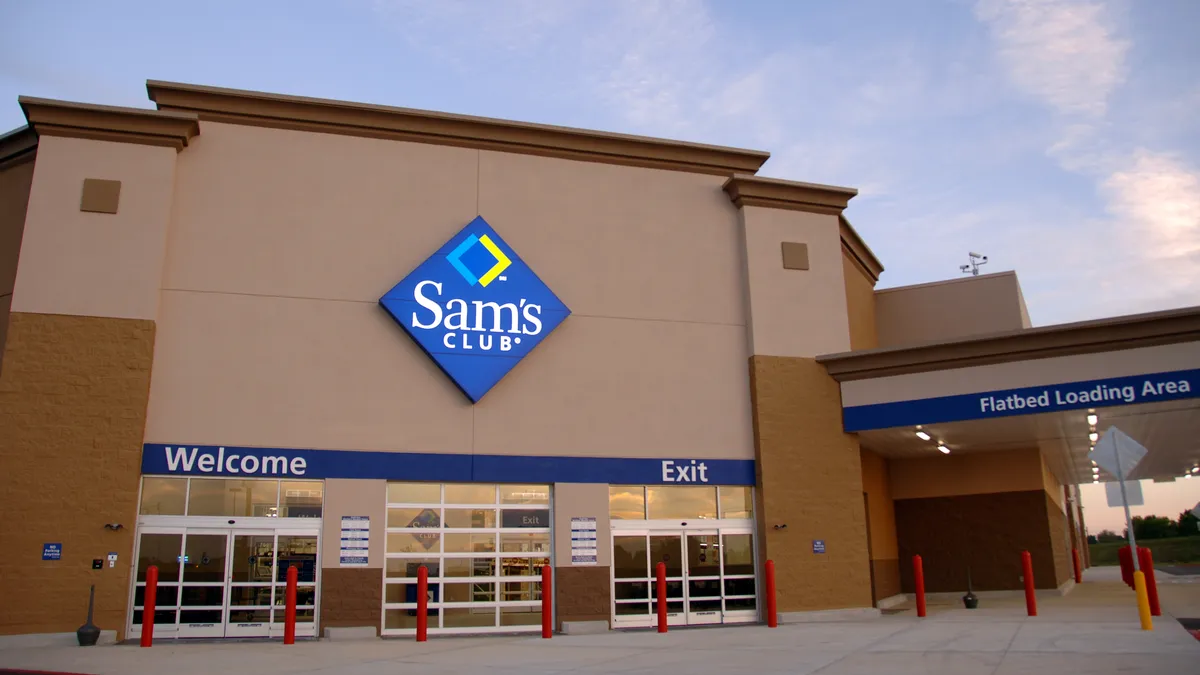Dive Brief:
-
Walmart on Thursday said that Sam's Club, its club-based retail warehouse division, will close 63 stores and convert as many as 12 of them to e-commerce fulfillment centers. The move will leave Sam's Club with 597 stores.
-
Those not converted will close "over the next few weeks," according to a company press release. Walmart is providing "support and resources" to employees affected by the move, including 60 days of pay and a bonus, also announced Thursday, that is part of a revamped hourly pay package, as well as severance to those eligible for it.
-
The company will record a discrete charge of approximately 14 cents per share related to the move, mostly in its fourth quarter, the company said, adding that further details will be shared, as appropriate, when the company releases quarterly results on Feb. 20.
Dive Insight:
The shift in Sam's Club's brick-and-mortar footprint is a neat encapsulation of Walmart's broader transformation. Until it acquired e-commerce startup Jet (and Jet founder Marc Lore) in 2016, Walmart had more or less left its e-commerce operations to drift.
Since that acquisition, however, the retailer has been doing what many analysts love to see in an era when Amazon dominates headlines—making dramatic changes to prove its mettle against the e-commerce giant. Citi Research analysts, for example, last month raised their rating for Walmart from neutral to buy in light of the retail giant's rising e-commerce sales, which they said proves the company can compete with Amazon.
It's not just more e-commerce, but also fewer stores. In October, Walmart announced its most scaled back brick-and-mortar growth in the U.S. in some 15 years, saying it would open 280 net new stores globally, with a focus on Mexico and China. In the U.S. that includes plans for 15 Supercenters and fewer than 10 of its smaller Neighborhood Markets stores.
"We like [Walmart's] aggressive and innovative strategies to leverage its store network, which we believe provides strategic advantages over both brick and mortar and online competition, to drive store, digital, and omnichannel growth," Cowen & Co. analysts said then, in a note emailed to Retail Dive. "We're pleased [Walmart] understands the future of retail is the consumer, as customers will not differentiate between shopping channels and will demand all-channel execution.”
Transforming the business means managing the company's real estate portfolio, John Furner, president and CEO of Sam's Club, said in a statement on Thursday. Indeed, Walmart's dominance hardly spares the company such fundamental changes, and retailers of all stripes can expect their footprints to be closely examined by investors, according to Moody's Lead Retail Analyst Charlie O'Shea.
"The closing of 63 Sam's Club locations, with redeployment for some to support Walmart's online business, confirms our view that every retailer, no matter how large or strong, needs to make critical assessments of their real estate assets to ensure their value is being maximized in the multi-channel retail world," he said in a note emailed to Retail Dive. "As retail continues to evolve, we believe these physical assets will be subject to stricter scrutiny as to their role in each company's overall strategic plan, with 'pruning' and re-allocation such as Walmart is doing with Sam's the rule rather than the exception."
Walmart may actually need to do even more shrinking. It's the world's largest retailer, with a massive brick-and-mortar network, and it isn't really tackling the enormity of that, some analysts say.
"I think they're sitting on one of the biggest liabilities in retail history — excess space of an unprecedented amount — and it's not being dealt with," Howard Davidowitz, chairman of New York City-based retail consulting and investment banking firm Davidowitz & Associates Inc., told Retail Dive. "All across the country we have too many stores, we're dramatically over-stored, stores are being downsized. Who has the most floor space by a multiple of anybody in the United States? Walmart! There are companies out there trying to do something about this problem, but Walmart's answer to the store space problem is to leave everything the way it is."













